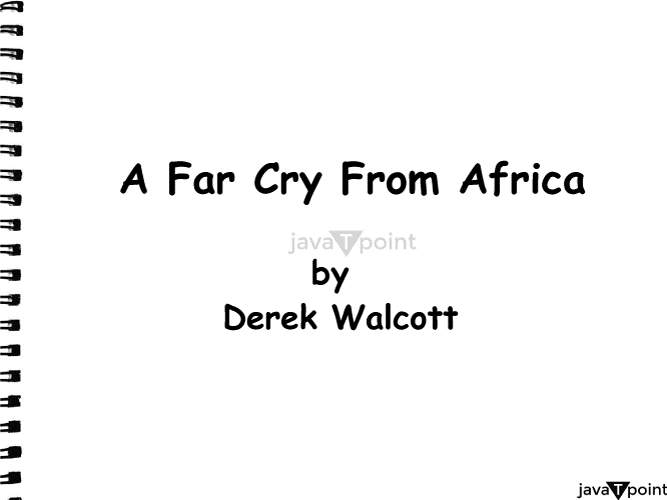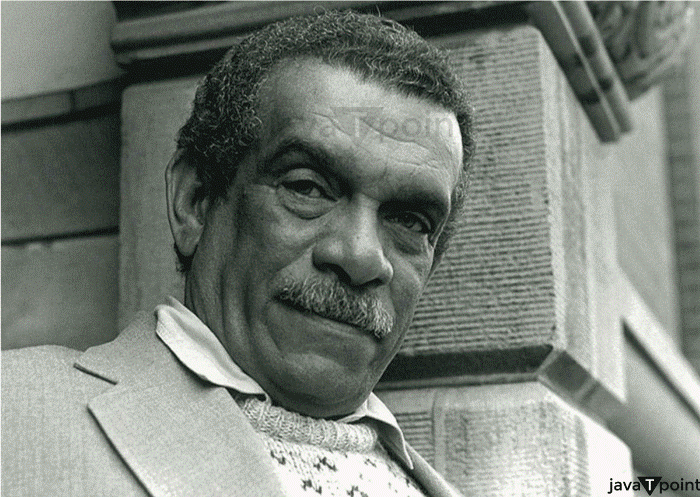A Far Cry from AfricaSummary
"A Far Cry from Africa" is a poem written by Derek Walcott, a well-known Caribbean poet, and was published in 1962. The British West Indies island of St. Lucia is where Nobel Prize laureate and educator Derek Walcott was born. He is also a writer, poet, artist, and teacher. The poem shows a commentary on the turbulent and challenging history of Africa, the hardships of its people, and the poet's own conflicting sentiments toward his African ancestry. Free verse was used to write it. It is divided into two stanzas, the first of which has twenty-one lines and the second, just eleven. Although end rhymes are widely used throughout the poem, it does not strictly rhyme. As a result, the poem feels stiff and disconnected, which reflects the emotions it expresses. The poetry has strong African roots. The poem has an African cultural vibe because of the language used. The title itself is intriguing. It indeed has two meanings. The word is used, and the obvious connotation is that the events are "far removed" from what you would anticipate in Africa. Still, the title is subversive & meant to be taken literally. i.e., there are crying people in Africa. The poem opens with a graphic and terrible depiction of the atrocities imposed on Africa through the ages, including the slave trade and colonial forces' exploitative use of its natural resources. The poet then discusses his own conflicting sentiments regarding his African ancestry, recognizing both the distance or dislocation he feels from the country and its people due to his birth in the Caribbean and his strong feelings of connection to both. The poem is renowned for its use of imagery and language, which rely on both African & European literary traditions. To communicate the nuance and complexity of his subject matter, the poet employs both formal & informal language and various literary devices, including metaphor and allusion. 
Detailed AnalysisLines 1-4"A wind is ruffling the tawny pelt (....) Corpses are scattered throughout a paradise. The first line depicts a wind blowing over the "veldt"?the term for the grasslands of Africa. The color & texture of the grass and other plants are called the "tawny pelt" of Africa, and the wind is said to be "ruffling" it. The Kikuyu, a Kenyan ethnic group, is mentioned by the speaker in the second line. The phrase "quick as flies" implies that the Kikuyu are swift and dexterous. The third line depicts the Kikuyu "batten[ing] upon the bloodstreams of the veldt," indicating they feed on the blood of animals in the grasslands. This statement serves as a metaphor for the bloodshed that is occurring as the Kikuyu rebels battle the British invaders during the Mau Mau insurrection. The fourth line states, "Corpses are scattered throughout a paradise." This claim seems incongruous because a paradise is typically associated with calm and beauty, and corpses imply violence and death. This sentence emphasizes the stark contrast between the continent of Africa's natural beauty and the brutality of its ongoing strife. Overall, the poem's opening four lines establish the tone for its detailed discussion of violence, identity, & colonialism. The imagery is both beautiful and frightening, and the language is metaphor-rich. Lines 5-9"Only the worm colonel of Carrion cries, (...) What is that to the white child hacked in bed? The fifth line reflects the horrible violence and death that have become the norm in Africa, turning the victims into nothing more than rotting flesh and bones. In the sixth line, the poet criticizes using statistics and academic research to support colonial policy. The quest for knowledge and comprehension turns into a means of defending and maintaining the policies of colonial powers. The seventh line encourages readers not to squander their sympathies on the particular war deaths and expresses a distanced viewpoint. It draws attention to the callousness and disregard for the pain and loss of life. In the eighth line, "salients" describes the strategic aspects or elements of the colonial strategy that academics emphasize. It implies that the focus is on some regions of interest, frequently ignoring such policies' wider ramifications and human costs. The last line addresses the arrogance and detached attitude of people criticizing colonial practices by posing a powerful rhetorical question. It explicitly mentions a white youngster harmed by violence to draw attention to the horrific reality of violence and its effects on innocent lives. These lines demonstrate how the poet contrasts political arguments and the brutal reality of violence and misery in the African environment. Lines 10-13"To savages, expendable as Jews? (...) Have wheeled since civilization's dawn. In the tenth line, the poet questions that Jews and Africans were seen as disposable or of little worth. The scene of the rushes being battered or thrashed symbolizes the ferocious damage brought on by war or battle. In the twelfth line, the poet depicts the aftermath of the devastation, as the air is filled with the screams of ibises, a species of bird. And in the thirteenth line, the poet emphasizes the pervasiveness of violence throughout history by implying that these birds have seen the development of civilization since prehistoric times. Overall, these lines demonstrate the poet's reflection on the dehumanization of African people and the cruelty of war, employing vivid imagery and historical connections to emphasize the long-term consequences of violence on society. Lines 14-17"From the parched river or beast-teeming plain. (...) Seeks his divinity by inflicting pain. The first two lines suggest examining animal violence and how it relates to human conduct. It prepares the ground for a comparison of human and animal aggression. It refers to the innate hostility that exists amongst animals in the wild. In order to survive, animals frequently fight or act in a predatory manner. The sixteenth-line distinction between humans and animals is emphasized. Animal aggression is seen as a normal occurrence, yet it suggests that people have the power to choose and may overcome their more primitive behaviors. The seventeenth line indicates that some people may inflict pain and injury on others to gain supremacy or authority. It suggests that there is a negative aspect to human nature where causing harm is considered a way to gain control or power. Overall, these lines address the idea that, despite violence being often associated with the animal realm, humans are also capable of transcendence and violence. It raises questions about the moral intricacies and decisions that humanity must make in the midst of violence and power struggles. Lines 18-21"Delirious as these worried beasts, his wars (...) Of the white peace contracted by his guile. The next four sentences are really intriguing. The identity of the "he" mentioned in these words is not entirely clear. According to the eighteenth line, human battles motivated by aspirations, ambitions, and disputes can be compared to animal distress behavior because they are illogical and frantic. The nineteenth sentence, which compares human battles to a drum fashioned from a stretched animal carcass, employs powerful imagery to capture the rhythm & intensity of the human conflict. It says that primitive urges and a destructive rhythm drive conflicts. The poetry here examines the idea of bravery in a time of conflict. It implies that people frequently describe their fear and dread as boldness, maybe to excuse or explain their violent behavior. The last line highlights the idea of a false or deceitful calm attained by cunning or deception. It suggests that the seeming calmness or peace upheld by people in authority may result from underlying manipulation or a secret goal. These lines show a critical viewpoint on human warfare by emphasizing its irrationality, the destructiveness of war, and the phoniness of the peace it purports to bring about. It questions the underlying motivations behind violence and the nuanced interplay between power, fear, and bravery. Lines 22-23"Again, brutish necessity wipes its hands Upon the napkin of a dirty cause, again The use of the word "again" implies that "brutish necessity" has happened before. "Brutish necessity" relates to the concept that violence is considered a necessary means to an aim, and "wipes its hands" implies that this violence is not something anybody wants to be connected with. The expression "the napkin of a dirty cause" refers to the rationalizations and defenses put up by both parties to support the use of force. The term "napkin" conjures up the idea of something that is quickly thrown away, and "dirty" emphasizes that these defenses are fragile and readily dismissed. The word "again" is used more than once, highlighting the fact that this cycle of aggression and defense keeps occurring. These two sentences imply that brutality and violence have developed into a recurrent pattern in African history and that both parties used flimsy explanations for these atrocities. The sentences imply that escaping this vicious cycle of rationalization and violence is challenging. Lines 24-27"A waste of our compassion, as with Spain, (...) Where shall I turn, divided to the vein? The twenty-fourth line refers to the Spanish Civil War, in which numerous volunteers worldwide fought for the Republicans. The implication is that these volunteers squandered their sympathy on a fight that wasn't changing anything. The twenty-fifth line metaphorically depicts the conflict between Africans (represented by the gorilla) and European conquerors (represented by Superman). The word "wrestles" implies this is a bloody and violent conflict. "Poisoned with the blood of both" implies that the speaker feels torn between these two realities and that this inner struggle hurts him. The rhetorical inquiry in this sentence highlights the speaker's sense of being torn between two realities. The idiom "divided to the vein" denotes a profound internal conflict and the speaker's struggle to find a method to bring these two aspects of his personality into harmony. Overall, from these words, the speaker is wrestling with his mixed-race identity and feels torn between two opposing worlds. The sentences also imply that the more significant fight between Europe and Africa is a harsh and deadly conflict that is hard to settle. Lines 28-33"I, who have cursed (...) How can I turn from Africa and live?" In response to the brutality and oppression of colonialism, the speaker considers their own anger and dissatisfaction. The speaker struggles with reconciling their love of the English language with the terrible effects performed by people who use it and makes special reference to the British colonial commanders who were frequently in charge of tyranny and bloodshed in Africa. The speaker feels conflicted between their love of their African background and their affinity for the English language and culture. The speaker questions whether they must decide between forsaking their ancestry, language, and culture or discovering a method to make them compatible. The speaker conveys their intense emotional distress in response to the bloodshed and violence in Africa. As the poem ends, the speaker wonders if it is possible to ignore Africa and its continuous fights for justice and freedom while leading a fulfilling and genuine life. ConclusionThe poem highlights the terrible effects of colonialism & oppression on African communities and uses particular historical occurrences to support this claim. The speaker faces challenging decisions and queries concerning their love for Africa & affinity for the English language and culture, which leaves the poem's ending with a feeling of unresolved tension. All things considered, "A Far Cry from Africa" is a moving and thought-provoking piece that poses significant issues regarding the effects of colonialism and the continuous fight for justice and independence.
Next TopicA Letter to God Summary
|
 For Videos Join Our Youtube Channel: Join Now
For Videos Join Our Youtube Channel: Join Now
Feedback
- Send your Feedback to [email protected]
Help Others, Please Share









